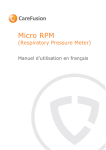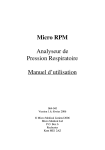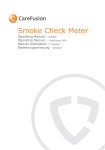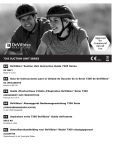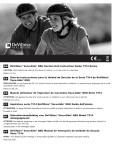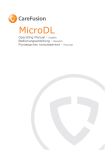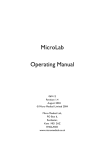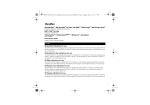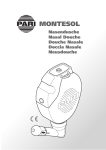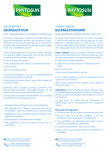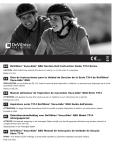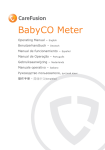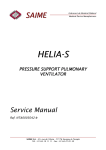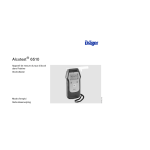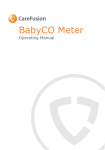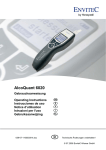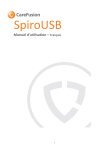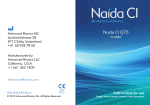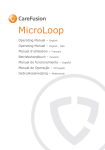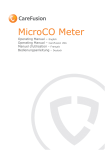Download "service manual"
Transcript
MicroRPM (Respiratory Pressure Meter) Operating Manual – English Operating Manual – CareFusion USA Manuel d’utilisation - Français Handleiding - Nederlands Руководство пользователя - Русский 1 Contents I. Introduction – English........................................................ 4 Contents .......................................................................... 5 Puma PC Software............................................................. 6 Operation – Mouth Pressures .............................................. 7 PImax (MIP) Test .............................................................. 8 PEmax (MEP) Test ............................................................. 8 Operation – SNIP .............................................................10 SNIP Test ........................................................................11 Battery ...........................................................................12 Cleaning .........................................................................12 Calibration ......................................................................12 Servicing.........................................................................14 Consumables and Acessories .............................................15 Symbols..........................................................................16 Environment....................................................................16 Specifications ..................................................................16 II. Introduction – CareFusion USA ..........................................18 Package Contents.............................................................19 Puma PC Software............................................................20 Operation – Mouth Pressures .............................................21 Operation – Sniff Nasal Inspiratory Pressure ........................23 Battery Low Voltage Indication...........................................24 PC Connection .................................................................24 Cleaning .........................................................................25 Calibration ......................................................................25 Servicing.........................................................................27 Consumables/ Supporting Products ....................................27 Symbols..........................................................................28 Environment....................................................................28 Specifications ..................................................................28 1 III. Introduction – Français .....................................................29 Contenu De L’emballage ...................................................30 Le logiciel PUMA ...............................................................32 Mode D’emploi – Pressions Buccales ...................................33 Mode D’emploi – Pression Inspiratoire Sniff Nasale ...............35 Témoin Du Niveau De Charge De La Pile .............................37 Connexion Au PC..............................................................37 Nettoyage .......................................................................37 Etalonnage ......................................................................38 Entretien.........................................................................40 Piéces De Rechange / Accessoires ......................................40 Symboles ........................................................................41 Environnement ................................................................41 Spécifications ..................................................................42 IV. Introductie - Nederlands ...................................................43 Inhound ..........................................................................44 PUMA PC Software............................................................45 Bediening – Mondruk ........................................................46 PImax (MIP) Test .............................................................46 PEmax (MEP) Test ............................................................47 Bedienung – SNIP (Sniff Nasal Inspiratory Pressure..............48 SNIP Test ........................................................................49 Batterij ...........................................................................50 Reiniging.........................................................................51 Kalibratie ........................................................................51 Service ...........................................................................53 Verbruiksgoederen en accessoires ......................................53 Symbolen........................................................................54 Bedrijfsomgeving .............................................................54 Specificaties ....................................................................55 2 V. Введение - Русский .........................................................56 Стандартные принадлежности..........................................57 PUMA PC Software............................................................58 Работа прибора – давление в полости рта ........................59 Работа прибора – назальное инспираторное давление.......61 Индикация снижения заряда батареи ...............................62 Подключение к ПК ..........................................................62 Очистка..........................................................................63 Калибровка ....................................................................63 Cервис ...........................................................................65 Дополнительные принадлежности / Расходный материал...65 Символы.........................................................................66 Окружающая среда .........................................................66 Технические характеристики ...........................................67 VI. Customer Contact Information ...........................................68 3 MicroRPM (Respiratory Pressure Meter) Operating manual I. Introduction - English The respiratory pressure meter is a hand held instrument designed for rapid assessment of inspiratory and expiratory muscle strength. The unit can measure the maximum inspiratory and expiratory mouth pressures, MIP and MEP, and the Sniff Nasal Inspiratory Pressure, SNIP. The result of each measurement is presented in units of cmH2O gauge pressure on the liquid crystal display screen. The unit is easy to operate, battery powered, and is supplied with all the necessary attachments required for immediate use. The functionality of the unit may be greatly increased when connected to a PC running PUMA software. This application has many advanced features including: • Real time display of pressure/time curves • Overlay of successive curves • Predicted values • Patient database • Incentive display • Manoeuvre quality check • Manoeuvre variability measurement 4 Contents The MicroRPM is supplied as follows: 1. MicroRPM Microcomputer Unit 2. Rubber Flanged Mouthpiece Cat. No. 36-MTH6400 3. Alkaline PP3 battery Cat. No. 36-BAT1002 4. Expiratory Pressure Valve Assembly Cat. No. 36-ASS1221 5. Inspiratory Pressure Valve Assembly Cat. No. 36-ASS1222 Cat. No. 36-MEC1299 6. Calibration Screwdriver 7. Nasal Probes Size 1-4 8. Nasal Probe Adapter 9. Mouth Pressure Bacterial Filters Cat. No. 36-ASS1091 Cat. No. 36-FIL6050 (50) 7 3 SNIP MIP / MEP OFF 8 4 3 2 1 9 6 2 1 5 4 5 PUMA PC Software The functionality of the portable MicroRPM is greatly increased when connected to the PUMA PC Software, via an RS232 cable to the Serial Port on the side of the unit. PUMA PC Software is available as a free download from www.carefusion.com/micromedical. Please contact Technical Services for installation instructions and system requirements. The PUMA PC Software is a unique, user friendly multi windows platform for the performance, storage and analysis of the respiratory muscle strength measurements of PImax or MIP (Maximum Inspiratory Pressure), PEmax or MEP (Maximum Expiratory Pressure) and SNIP (Sniff Nasal Inspiratory Pressure). In addition, PUMA PC Software offers the user features such as live graphical displays, predicted values, printing formats, incentives, trends, post medication or exercise comparisons and additional fatigue indicators. 6 Operation – Mouth Pressures (PImax/MIP + PEmax/MEP) Insert the battery into the compartment at the rear of the MicroRPM. Fit the required Pressure Valve Assembly (‘Inspiratory’ for PImax (MIP), ‘Expiratory’ for PEmax (MEP)) into the MicroRPM; insert a new Bacterial Filter into the Pressure Valve Assembly and then the Rubber Flanged Mouthpiece onto the Bacterial Filter, as shown below. 7 PImax (MIP) Test Slide the MicroRPM switch from ‘Off’ to ‘MIP/MEP’, whilst applying no pressure to the mouthpiece. Rotating segments will be displayed whilst the unit performs an auto-zero function. When the MicroRPM is ready a ‘beep’ will be heard and ‘0’ displayed. To perform the test instruct the subject to insert the mouthpiece into the mouth, ensuring the flange is positioned over the gums and inside the lips, whilst the ‘bite blocks’ are between the teeth. The subject should then exhale to RV (Residual Volume), lungs empty, then perform a ‘Mueller’ manoeuvre, a forced inhalation against the MicroRPM with as much effort as possible for as long as possible (minimum 2 seconds). The display will report the result, the maximum average inspiratory pressure sustained over a 1 second period of the test, in centimetres of water (cmH2O). Ideally, the subject should repeat this test 3 times to ascertain a best value. PEmax (MEP) Test Slide the MicroRPM switch from ‘Off’ to ‘MIP/MEP’, whilst applying no pressure to the mouthpiece. Rotating segments will be displayed whilst the unit performs an auto-zero function. When the MicroRPM is ready a ‘beep’ will be heard and ‘0’ displayed. To perform the test instruct the subject to insert the mouthpiece into the mouth, ensuring the flange is positioned over the gums and inside the lips, whilst the ‘bite blocks’ are between the teeth. 8 The subject should then inhale to TLC (Total Lung Capacity), lungs full, then perform a ‘Valsalva’ manoeuvre, a forced exhalation against the MicroRPM with as much effort as possible for as long as possible (minimum 2 seconds). The display will report the result, the maximum average expiratory pressure sustained over a 1 second period of the test, in cmH2O. Ideally, the subject should repeat this test 3 times to ascertain a best value. To repeat either the PImax or PEmax tests the MicroRPM must firstly be returned to the ‘Off’ position. _____ For more information on these procedures, and for interactive presentations and video demonstrations, go to our dedicated website: WWW.RESPIRATORYMUSCLES.COM ____ 9 Operation – SNIP (Sniff Nasal Inspiratory Pressure) Insert the battery into the rear of the MicroRPM. Fit the Nasal Probe Adapter into the MicroRPM and then attach the correct size Nasal Probe, as shown below. The correct size (1-4) can be ascertained by fitting a Nasal Probe to the unit, then firmly inserting the Nasal Probe into a nostril. Instruct the subject to block the open nostril with a finger and then to attempt a sniff. The correct Nasal Probe size has been selected once there is no leakage around the Nasal Probe. 2 Nasal probe Nasal plug adapter Microcomputer unit 10 SNIP Test Slide the MicroRPM switch from ‘Off’ to ‘SNIP’, whilst applying no pressure to the Nasal Probe. Rotating segments will be displayed whilst the unit performs an auto-zero function. When the MicroRPM is ready a ‘beep’ will be heard and ‘0’ displayed. To perform the test, instruct the subject to insert the chosen Nasal Probe firmly into a nostril, whilst ensuring the other nostril remains open throughout the test. The subject should then breathe normally and at the end of a normal tidal expiration, FRC (Functional Residual Capacity), be instructed to perform a short, sharp voluntary sniffing manoeuvre with as much effort as possible. The display will report the result, the peak inspiratory nasal pressure, in cmH2O. On subsequent tests the MicroRPM will continue to display the highest SNIP value, overwriting previous values. Ideally, the subject should repeat this test 10-15 times to ascertain the highest value. ____ For more information on these procedures, and for interactive presentations and video demonstrations, go to our dedicated website: WWW.RESPIRATORYMUSCLES.COM ____ 11 Battery The battery level is automatically checked when the unit is switched on. When the battery is low ‘bAt’ will be displayed before the auto-zero procedure. The MicroRPM may be used when this occurs, but the battery should be replaced as soon as possible. When the battery is completely exhausted the unit will beep twice and turn itself off immediately. Note: If the MicroRPM is not to be used for long periods the battery should be removed to prevent damage by a possible leak. Cleaning The MicroRPM unit requires no routine maintenance and is protected from contamination by the Bacterial Filter (36-FIL6050). The Rubber Flanged Mouthpiece (36-MTH6400) and Nasal Probes, however, may be immersed in a cold sterilising solution such as PeraSafe (36-SSC5000A). Rinse thoroughly and leave to dry before reassembly. The Nasal Probes can additionally be dried with a flow of air provided by the CareFusion Nasal Probe Pump (36-MEC1219). Calibration The calibration is factory set and should remain stable indefinitely. The calibration may be checked and altered, however, by connecting the device via the Pressure Calibration Kit (36-ASS1234) to a Water Manometer, as shown below: 12 Connecting line Female Luer T Piece Nasal plug adapter 10 9 Syringe 8 7 6 5 4 3 2 1 0 Manometer cm H 2O Slide the MicroRPM switch from ‘Off’ to ‘SNIP’ whilst applying no pressure to the unit. Gently fill the syringe until negative pressure of between 200 and 300cmH2O is read on the Water Manometer. Check that the reading on the MicroRPM is within 3% of this reading. Please Note: Calibration can only be adjusted in a positive direction, as the MicroRPM measures the highest peak value. Therefore, if the reading was greater than that on the Water Manometer, the calibration screw must be turned anti-clockwise first, before calibration is attempted. 13 Serial port Calibration screw To calibrate the MicroRPM, connect to the Water Manometer as before, filling the syringe to obtain the required negative pressure. To change the calibration, slowly turn the calibration screw in a clockwise direction until the same value is displayed on the MicroRPM. Servicing If your unit requires service or repair please see page 68 for contact details. A full service manual including circuit diagrams and parts list is available on request. 14 Consumables and Accessories Cat. No. Description 36-FIL6050 Bacterial Filters (50 per box) 36-MTH6400 Rubber Flanged Mouthpiece 36-ASS1221 Expiratory Pressure Valve Assembly 36-ASS1222 Inspiratory Pressure Valve Assembly 36-NPROBE01 Extra Small Nasal Probes (10 per box) 36-NPROBE02 Small Nasal Probes (10 per box) 36-NPROBE03 Medium Nasal Probes (10 per box) 36-NPROBE04 Large Nasal Probes (10 per box) 36-ASS1091 Nasal Probe Adapter 36-MEC1299 Calibration Screwdriver 36-BAT1002 Alkaline PP3 Battery 36-SSC5000A PeraSafe Sterilising Powder – 81g (Makes 5 litres of solution) 36-ASS1234 Pressure Calibration Kit Caution • Pulmonary filters are single patient use. If used on more than one patient there is a risk of cross-infection. Repeat use may increase air resistance and lead to an incorrect measurement. 15 Symbols Type B device In accordance with Directive 93/42/EEC 0086 Disposal in compliance with WEEE Environment This instrument complies with directive EN60601-1-2 electromagnetic compatibility but can be affected by cellular phones and by electromagnetic interference exceeding levels specified in EN 50082-1:1992 Specifications Operating Pressure: +/- 300cmH2O Burst Pressure: +/- 700cmH2O Accuracy: +/-3% Resolution: 1cmH2O Power Supply: Single 9v PP3 Dimensions: 170 x 60 x 26mm Weight (unit with battery): 175g Weight (in carry case) : 750g Operating Temperature : 0 - 40 °C Operating Humidity: 30% - 90% RH Storage Temperature: -20 - +70 ° C Storage Humidity: 10% - 90% RH 16 MicroRPM (Respiratory Pressure Meter) Operating manual Federal (USA) law restricts this device to sale by or on the order of a physician or licensed practitioner. CareFusion, 22745 Savi Ranch Parkway, Yorba Linda CA 92887-4668 USA 17 II. Introduction – CareFusion USA The respiratory pressure meter is a hand held instrument designed for rapid assessment of inspiratory and expiratory muscle strength. The unit can measure the maximum inspiratory and expiratory mouth pressures, MIP and MEP, and the Sniff Nasal Inspiratory Pressure, SNIP. The result of each measurement is presented in units of cmH2O gauge pressure on the liquid crystal display screen. The unit is easy to operate, battery powered, and is supplied with all the necessary attachments required for immediate use. The functionality of the unit may be greatly increased when connected to a PC running PUMA software. This application has many advanced features including: • Real time display of pressure/time curves • Overlay of successive curves • Predicted values • Patient database • Incentive display • Manoeuvre quality check • Manoeuvre variability measurement 18 Package Contents The respiratory pressure meter is supplied with the following items:1. Microcomputer unit 2. Rubber mouthpiece 3. Alkaline PP3 battery 4. Expiration pressure valve assembly 5. Inspiration pressure valve assembly 6. Calibration screwdriver 7. Nasal probe sizes 1 to 4 8. Nasal probe adapter 9. Mouth pressure bacterial filters 7 3 SNIP MIP / MEP OFF 8 4 3 2 1 9 6 2 1 5 4 19 PUMA PC Software The functionality of the portable MicroRPM is greatly increased when connected to the PUMA PC Software, via an RS232 cable to the Serial Port on the side of the unit. PUMA PC Software is available as a free download from www.carefusion.com/micromedical. Please contact Technical Services for installation instructions and system requirements. The PUMA PC Software is a unique, user friendly multi windows platform for the performance, storage and analysis of the respiratory muscle strength measurements of PImax or MIP (Maximum Inspiratory Pressure), PEmax or MEP (Maximum Expiratory Pressure) and SNIP (Sniff Nasal Inspiratory Pressure). In addition, PUMA PC Software offers the user features such as live graphical displays, predicted values, printing formats, incentives, trends, post medication or exercise comparisons and additional fatigue indicators. 20 Operation – Mouth Pressures Insert the battery into the battery compartment at the rear of the unit, fit the flanged rubber mouthpiece over the required valve assembly and insert into the respiratory pressure meter as shown below: Two valve assemblies are provided. The one marked expiration pressure allows the patient to inspire fully through the valve, which then closes during expiration to allow the meter to measure the maximum expired pressure averaged over one second. The valve marked inspiratory pressure works in the exact opposite manner. To measure the maximum expiratory pressure (PEmax), slide the switch from the “off” position to the MIP/MEP position. Rotating 21 segments will be displayed whilst the unit performs an auto-zero function. During this time there should be no applied pressure. When the unit is ready for use 0 will be displayed. To perform an expiratory pressure test instruct the subject to insert the mouthpiece into the mouth ensuring that the flange is positioned over the gums and inside the lips and that the “bite blocks” are between the teeth. They should then inhale to TLC (total lung capacity) and then exhale with as much effort as possible through the controlled leak of the meter for at least 2 seconds. The reading displayed is the maximum average expiratory pressure over 1 second. For an accurate measurement it is important that there are no leaks in the system other than the small controlled leak of the instrument. This leak prevents the generation of a false high reading generated by closure of the glottis and compression of air in the mouth using the facial muscles. Before repeating the measurement, or before performing an inspiratory manoeuvre, the instrument must be reset by sliding the switch to the “off” position. To measure the maximum inspiratory pressure (PImax) follow the above procedure but with the valve marked inspiratory pressure connected. Slide the switch on the face of the meter from ‘off’ position to the MIP/MEP position and instruct the subject to exhale to RV (residual volume) through the mouthpiece and then to inhale with as much effort as possible for at least 2 seconds. The reading displayed is the maximum average inspiratory pressure that was sustained over 1 second. 22 Operation – Sniff Nasal Inspiratory Pressure Before commencing a test the correct size of nasal probe to be used must be ascertained. The unit is supplied with four sizes designed to cover a wide range of nostrils. Select the size that appears to be the most appropriate, connect it to the unit as shown below, and ask the subject to insert the probe firmly into a nostril. Once fitted the subject should close the other nostril with a finger and try to inhale through the probe to check the sealing. When the correct size has been selected proceed as follows: Insert the battery into the battery compartment at the rear of the unit, fit the selected probe as shown below: 2 Nasal probe Nasal plug adapter Microcomputer unit To measure the maximum sniff inspiratory pressure, slide the switch from the “off” position to the SNIP position. Rotating segments will be displayed whilst the unit performs an auto-zero function. During this time there should be no applied pressure. 23 When the unit is ready for use 0 will be displayed. To perform a SNIP test instruct the subject to insert the nasal probe into a nostril such that a good seal is made. After a normal expiration they should inhale with as much effort as possible through the free nostril with the mouth closed. The manoeuvre is performed from functional residual volume (FRC). The reading displayed is the peak inspiratory nasal pressure. Before repeating the measurement, the instrument must be reset by sliding the switch to the “off” position. Battery Low Voltage Indication The battery level is checked when the unit is switched on. When the battery is nearly exhausted ‘bAt’ is displayed before the auto-zero procedure begins. The unit may be used when this occurs provided the test is performed immediately. The battery should be replaced as soon as possible. When the battery is completely exhausted the unit will beep twice and turn itself off immediately after turning on. Note: If the respiratory pressure meter is not used for long periods, the battery should be removed to prevent damage to the instrument by possible leakage. PC Connection The respiratory pressure meter may be connected to a computer running PUMA software via the RS232 serial port on the left hand side of the unit. 24 Cleaning The respiratory pressure meter requires no routine maintenance or servicing and is protected from contamination by the bacterial filter supplied. However the mouthpiece and nasal probes may be immersed in cold sterilising solutions such as PeraSafe for a period not exceeding 15 minutes. Rinse with distilled water, drain, and allow to dry before reassembly. A flow of air through the nasal probe connecting tube may be introduced to shorten the drying time. CareFusion can supply a pump for this purpose – see Consumables/Supporting products, page 27. PeraSafe is available from CareFusion in convenient 81g, plastic containers. Calibration Calibration is factory set and should remain stable indefinitely. However, calibration may be checked by connecting the device to a manometer as shown below: Connecting line Female Luer T Piece 10 9 Syringe 8 7 6 5 4 3 2 1 0 Manometer cm H 2O 25 Nasal plug adapter Turn the respiratory pressure meter on to the SNIP position. Very slowly fill the syringe until a negative pressure of between 200 and 300cm is obtained on the manometer. Check that the reading on the respiratory pressure meter is within 3% of the manometer reading. If adjustment is required then the following procedure must be followed. The calibration may only be adjusted in a positive direction as the meter monitors the peak pressure value. Therefore if the respiratory pressure meter reading was greater than the manometer reading the calibration screw must be turned anti-clockwise a few turns before calibration is attempted. Serial port Calibration screw Connect the respiratory pressure meter to the manometer as previously shown. Fill the syringe to obtain the required negative 26 pressure and then turn the calibration screw slowly in a clockwise direction until the same value is displayed on the meter. Servicing If your unit requires service or repair please see page 68 for contact details. A full service manual including circuit diagrams and parts list is available on request. Consumables / Supporting Products Description Expiratory Pressure Valve Assembly Inspiratory Pressure Valve Assembly Bacterial Filters (50 per box) Extra Small Nasal Probes (10 per box) Small Nasal Probes (10 per box) Medium Nasal Probes (10 per box) Large Nasal Probes (10 per box) Nasal Probe Adapter Calibration Screwdriver Alkaline PP3 Battery PeraSafe Sterilising Powder – 81g (Makes 5 litres of solution) Pressure Calibration Kit To place an order for consumables/supporting products or for general enquiries please contact CareFusion or contact your local CareFusion dealer. For US Customer Care: Toll Free 1-800-231-2466, phone 1-714283-2228 27 Caution • Pulmonary filters are single patient use. If used on more than one patient there is a risk of cross-infection. Repeat use may increase air resistance and lead to an incorrect measurement. Symbols Type B device Environment This instrument complies with directive EN60601-1-2 electromagnetic compatibility but can be affected by cellular phones and by electromagnetic interference exceeding levels specified in EN 50082-1:1992 Specifications Operating Pressure: +/- 300cmH2O Burst Pressure: +/- 700cmH2O Accuracy: +/-3% Resolution: 1cmH2O Power Supply: Single 9v PP3 Dimensions: 170 x 60 x 26mm Weight (unit with battery): 175g. Weight (in carry case) : 750g Operating Temperature : 0 - 40 °C Operating Humidity: 30% - 90% RH Storage Temperature: -20 - +70 °C Storage Humidity: 10% - 90% RH 28 MicroRPM (Analyseur de Pression Respiratoire) Manuel d’utilisation III. Introduction - Français L’analyseur CareFusion est un instrument portable conçu pour évaluer rapidement le niveau de force musculaire inspiratoire et expiratoire. L’appareil mesure les pressions buccales inspiratoires et expiratoires maximum, (PImax et PEmax), et la pression inspiratoire sniff nasale (SNIP). Le résultat de chaque analyse est présenté sous forme d’unités de pression manométrique en cmH2O sur l’écran d’affichage à cristaux liquides. L’appareil est facile à utiliser, alimenté sur piles et il est livré avec tous les accessoires nécessaires à son utilisation immédiate. La fonctionnalité de l’appareil peut être largement améliorée en le branchant sur un PC équipé du programme logiciel PUMA. Cette application présente de nombreuses caractéristiques innovantes, dont: • Affichage en temps réel de la pression/ des courbes de temps • Superposition des courbes successives • Valeurs prédites • Base de données patients • Image d’écran stimulant l’effort du sujet 29 • Vitesse maximale de développement de pression, MRPD • Vitesse maximale de relaxation, MRR • Contrôle de qualité du test • Mesure de la variabilité du test Contenu De L’emballage L’analyseur MicroRPM de CareFusion est livré avec les pièces suivantes: 1. Unité Centrale MicroRPM 2. Embout buccal caoutchouté, N° d’article 36-MTH6400 3. Pile alcaline PP3, N° d’article 36-BAT1002 4. Valve de pression expiratoire, N° d’article 36-ASS1221 5. Valve de pression inspiratoire, N° d’article 36-ASS1222 6. Tournevis d’étalonnage, N° d’article 36-MEC1299 7. Sondes nasales de calibre 1 à 4, 8. Raccord de sonde nasale N° d’article 36-ASS1091 9. Filtres anti-bactériens de pression buccale, N° d’article 36-FIL6050 (50 unités) 30 7 3 SNIP MIP / MEP OFF 8 4 3 2 1 9 6 2 1 5 4 31 Le logiciel PUMA Les fonctionnalités du MicroRPM portable sont largement plus nombreuses et avantageuses lorsqu’il est connecté à un ordinateur PC équipé du logiciel PUMA, via un câble RS232 série qui se branche sur le côté de l’appareil. Le logiciel PUMA est disponible en téléchargement sur le site www.carefusion.com/micromedical. Sélectionnez RPM et choisissez les liens appropriés. Veuillez contacter les départements techniques pour des instructions d’installation et les minimas requis au niveau du système. Le logiciel PUMA est unique, convivial avec sa plateforme à multifenêtres, performant, permettant le stockage et l’analyse des mesures de force respiratoire de la PImax (pression inspiratoire maximale), de la PEmax (pression expiratoire maximale) et du Sniff test (pression nasale inspiratoire maximale). Ajouté à cela, PUMA permet de bénéficier de fonctions telles que l’affichage de la courbe en direct, la fourniture de valeurs prédites, différents formats d’impression, une animation ludique pendant l’examen, des tendances, la possibilité de faire des tests après médication (post), des indicateurs de fatigue. 32 Mode D’emploi – Pressions Buccales Introduire la pile dans le compartiment situé à l’arrière de l’appareil, placer l’embout buccal sur le filtre lui-même inséré dansr la valve adéquate et enfoncer dans l’analyseur selon les illustrations cidessous: Mouthpiece Embout buccal Mouth pressure bacterial filter Filtre buccal anti-bactérien Valve assembly Valve Respiratory pressure meter Analyseur de pression respiratoire 33 L’appareil est livré avec deux valves. Celle qui est destinée à la pression d’expiration (les deux valves se distinguent par leur inscription respective) permet au patient d’inspirer complètement par la valve qui se referme ensuite durant l’expiration pour que l’analyseur puisse mesurer la pression expirée maximale moyenne sur une seconde. La valve de pression inspiratoire fonctionne exactement à l’inverse de la valve de pression expiratoire. Pour mesurer la pression expiratoire maximum (PEmax), faire glisser le bouton de la position “off” à la position MIP/MEP. Des segments rotatifs s’affichent pendant que l’appareil se règle par fonction autozéro. Attention à ne pas exercer de pression jusqu’à ce que cette opération soit terminée. Lorsque l’appareil est prêt à être utilisé, un 0 s’affiche. Pour tester la pression expiratoire, demander au sujet de placer l’embout buccal dans sa bouche en s’assurant que le collet est placé sur les gencives et sous les lèvres et que les pièces à mordre sont situées entre le dents. Il doit ensuite inspirer au maximum de sa CPT (Capacité Pulmonaire Totale) avant d’expirer de toutes ses forces à travers le dispositif de fuite de l’analyseur pendant au moins deux secondes. La valeur affichée est la pression expiratoire maximale moyenne sur une seconde. Pour obtenir un résultat précis, il est important de s’assurer qu’il n’y a pas de fuite dans le circuit à l’exception du petit dispositif de fuite de l’instrument. Ce dernier est conçu pour éviter les résultats artificiellement élevés dus à la fermeture de la glotte et la compression de l’air dans la bouche par les muscles faciaux. 34 Avant de recommencer l’analyse ou d’effectuer un test inspiratoire, l’instrument devra être réinitialisé en déplaçant le bouton sur la position off. Pour mesurer la pression inspiratoire maximale (PImax) il suffit également de suivre les instructions ci-dessus après avoir branché la valve de pression inspiratoire sur l’appareil. Positionner le bouton en position MIP/ MEP à partir de la position off et demander au sujet d’expirer au Volume Résiduel (VR) à travers l’embout buccal avant d’inspirer de toute force pendant au moins deux secondes. La valeur affichée est la pression inspiratoire maximale moyenne sur une seconde. Mode D’emploi – Pression Inspiratoire Sniff Nasale Avant de procéder à l’analyse, il faudra choisir le calibre de sonde nasale adéquat pour le sujet. L’appareil est livré avec quatre calibres de sondes différents afin de pouvoir adapter ces dernières à toutes les tailles de narines. Choisir la taille qui semble la mieux adaptée au sujet, branchez-la à l’appareil selon les illustrations ci-dessous et demandez au sujet de bien introduire la sonde dans sa narine. Une fois la sonde placée, le sujet devra se boucher l’autre narine du doigt et essayer d’inspirer à travers la sonde pour vérifier que la narine est totalement bouchée. Une fois le calibre correct sélectionné, poursuivre comme suit: Placer la pile dans le compartiment à piles situé à l’arrière de l’appareil et poser la sonde choisie selon les illustrations ci-dessous: 35 2 Nasal probe Nasal plug adapter Microcomputer unit Nasal probe Sonde nasale Nasal plug adapter Raccord de sonde nasale Microcomputer unit Micro-ordinateur Pour mesurer la pression inspiratoire sniff nasale maximale, faire glisser le bouton de la position “off” à la position SNIP. Des segments rotatifs apparaissent pendant que l’appareil se règle par fonction autozéro. Attention à ne pas exercer de pression jusqu’à ce que cette opération soit terminée. Lorsque l’appareil est prêt à être utilisé, un 0 s’affiche. Pour effectuer une analyse SNIP, demander au sujet d’introduire la sonde nasale de façon à ce que la narine soit complètement bouchée. Après une expiration normale, il devra inspirer aussi fort que possible par la narine non bouchée en maintenant la bouche fermée. Ce test 36 est réalisé à partir de la capacité résiduelle fonctionnelle (CRF). La valeur affichée est la pression inspiratoire nasale de crête. Avant de recommencer l’analyse, l’instrument devra être réinitialisé en déplaçant le bouton sur la position off. Témoin Du Niveau De Charge De La Pile Le niveau de la pile est contrôlé au moment de la mise sous tension de l’appareil. Lorsque la pile arrive en fin de vie, la mention ‘bAt’ s’affiche sur l’écran avant le démarrage du réglage autozéro. L’appareil pourra alors tout de même être utilisé à condition d’effectuer l’analyse tout de suite. La pile devra être changée dès que possible. Lorsque la pile est totalement usée, l’appareil émet deux bips sonores avant de s’éteindre automatiquement dès sa mise sous tension. Remarque: Lorsque l’analyseur ne doit pas être utilisé pendant de longues périodes, veiller à enlever la pile afin d’éviter les dégâts potentiels sur l’instrument pouvant être causés par les fuites. Connexion Au PC L’analyseur devra être relié à un ordinateur équipé du logiciel PUMA en le branchant sur le port série RS232 situé à gauche de l’appareil. Nettoyage L’analyseur ne demande aucun nettoyage ou entretien régulier et il est protégé de la contamination par le filtre anti-bactérien avec lequel il est livré. Il sera toutefois possible de stériliser l’embout buccal et les sondes nasales en les plongeant dans des solutions stérilisantes telles que PeraSafe ou Anios pendant un maximum de 15 minutes. Rincer les pièces à l’eau distillée, les égoutter puis les laisser sécher avant de les remonter. Il est possible de faire passer de l’air dans le tube de 37 raccord de la sonde nasale afin d’accélérer son séchage. CareFusion commercialise une pompe à cet effet – voir la liste de pièces de rechange et accessoires en page 40. PeraSafe peut être obtenue auprès de CareFusion sous forme de récipients en plastique de 81g, N° d’article 36-SSC5000A Etalonnage L’appareil est étalonné en usine et est conçu pour rester stable indéfiniment. Cependant, l’étalonnage pourra être testé en branchant l’appareil à un manomètre suivant l’illustration ci-dessous: Connecting line Female Luer T Piece Nasal plug adapter 10 9 Syringe 8 7 6 5 4 3 2 1 0 Manometer cm H 2O Connecting line Cordon de raccordement Female Luer T piece Raccord Luer femelle en T Nasal plug adapter Raccord de sonde nasale Syringe Seringue Manometer Manomètre 38 Mettez l’analyseur en position SNIP. En procédant très lentement, remplissez la seringue jusqu’à ce que le manomètre affiche une pression négative située entre 200 et 300cm. Contrôler que la différence entre le résultat affiché sur l’analyseur et le résultat du manomètre est inférieure à 3%. Au cas où un réglage soit nécessaire, réglez l’appareil selon les instructions suivantes: L’étalonnage ne pourra être effectué que dans le sens positif étant donné que l’analyseur contrôle la pression de crête. Ainsi, si le résultat de l’analyseur est supérieur à celui du manomètre, la vis d’étalonnage devra être serrée dans le sens inverse des aiguilles d’une montre avant de procéder à l’étalonnage. Serial port Calibration screw Serial port Port série Calibration screw Vis d’étalonnage 39 Brancher l’analyseur au manomètre selon les indications précédentes. Remplir la seringue au maximum pour obtenir une pression négative avant de visser la vis d’étalonnage dans le sens des aiguilles d’une montre jusqu’à ce que la même valeur s’affiche sur l’analyseur. Entretien Si votre appareil nécessite un entretien ou un dépannage, consulter la page 68 pour obtenir les coordonnées correspondantes. Un manuel d’entretien complet avec les diagrammes des circuits et une liste des pièces est disponible sur demande. Pièces De Rechange / Accessoires N° D’article Description 36-MTH6400 Embout buccal caoutchouté 36-ASS1221 Valve de pression d’expiration 36-ASS1222 Valve de pression d’inspiration 36-FIL6050 Filtres anti-bactériens de pression buccale (50 unités par boîte) 36-NPROBE01 Sondes nasales très petit calibre (10 unités par boîte) 36-NPROBE02 Sondes nasales petit calibre (10 unités par boîte) 36-NPROBE03 Sondes nasales moyen calibre (10 unités par boîte) 36-NPROBE04 Sondes nasales gros calibre (10 unités par boîte) 36-ASS1091 Raccord de sonde nasale 36-MEC1299 Tournevis d’étalonnage 36-BAT1002 Pile alcaline PP3 36-SSC5000A Poudre stérilisante PeraSafe - 81g (Pour obtenir jusqu’à 5 litres de solution) 36-ASS1234 Kit d'étalonnage de pression 40 Précautions d'emploi • Les embouts buccaux sont à usage sur un seul patient. L'utilisation sur plusieurs patients entraîne un risque de surinfection. Une utilisation répétée peut entraîner une détérioration des matériaux et fausser les mesures. Pour placer une commande de pièces de rechange ou d’accessoires ou pour toute question d’ordre général, veuillez contacter le représentant français de CareFusion aux coordonnées suivantes. Symboles Appareil de catégorie B Conforme à La directive 93/42/EEC 0086 Disposition conformément à WEEE Environnement Cet appareil est conforme à la directive EN60601-1-2 concernant la compatibilité électromagnétique, mais il est potentiellement sensible aux interférences des téléphones portables et aux interférences magnétiques supérieures aux niveaux spécifiés dans la norme EN 50082-1:1992 41 Spécifications Pression de fonctionnement: +/- 300cmH2O Pression de rupture: +/- 700cmH2O Précision: +/-3% Résolution: 1cmH2O Alimentation: Une seule pile PP3 9v Dimensions: 170 x 60 x 26mm Poids avec pile: 174 grammes. Poids avec housse: 750 grammes Température de fonctionnement: Entre 0 et +40 °C Humidité de fonctionnement: Entre 30% et 90% RH Température de stockage: Entre -20 et + 70 °C Humidité de stockage Entre 10% et 90% RH 42 MicroRPM (Respiratory Pressure Meter) Handleiding IV. Introductie - Nederlands De meter voor respiratoire drukken is een klein en handzaam instrument dat snel inspiratoire en expiratoire drukken meet. Het instrument kan de maximale inspiratoire en expiratoire drukken aan de mond meten, MIP en MEP en ook “Sniff Nasal Inspiratory Pressure” (SNIP). De waarden van de metingen worden weergegeven in cm H2O op een LCD scherm. Het instrument is gemakkelijk te bedienen en werkt op batterijen. Het instrument wordt geleverd met alle toebehoren om direct gebruikt te kunnen worden. Aan dit instrument kunt U extra mogelijkheden toevoegen indien het wordt aangesloten op een PC met PUMA software. Deze applicatie biedt vele geavanceerde voordelen waaronder: • Real time weergave van de druk/ tijd curven • Simultane weergave van opeenvolgende curven • Normwaarden • Database patiëntengegevens • Grafische coaching van de manoeuvre • Indicatie variabiliteit onderlinge testen 43 Inhoud De MicroRPM wordt als volgt geleverd: 1. MicroRPM microcomputer-eenheid 2. Siliconen Bit Mondstuk Cat.nr. 36-MTH6400 3. Alkaline PP3 batterij Cat.nr. 36-BAT1002 4. Expiratoire Eenwegklep MicroRPM Cat.nr. 36-ASS1221 5. Inspiratoire Eenwegklep MicroRPM Cat.nr. 36-ASS1222 6. Kalibratieschroevendraaier Cat.nr. 36-MEC1299 7. Nasale Pluggen Maat 1-4 8. Nasale plug-adapter Cat.nr. 336-ASS1091 9. Bacteriefilter Cat.nr. 36-FIL6050 (50) 7 3 SNIP MIP / MEP OFF 8 4 3 2 1 9 6 2 1 5 4 44 PUMA PC Software De functionaliteit van de draagbare MicroRPM neemt aanzienlijk toe door aansluiting op de PUMA PC Software, via een RS232-kabel aan de seriële poort van het apparaat. PC software kan gratis worden gedownload via deze link: www.carefusion.com/micromedical. Kies bij MicroRPM Product details”, “related links” (rechts boven in scherm), “PC software downloads”, onder “PUMA PC Software” klikt U op “click here”. Voor vragen over installatie of systeemvereisten kunt U contact opnemen met onze Service afdeling. De PUMA PC Software is een uniek, gebruiksvriendelijk multivensterplatform voor de uitvoering, opslag en analyse van de respiratoire spierkrachtmetingen van PImax of MIP (Maximale Inspiratoire Druk), PEmax of MEP (Maximale Expiratoire Druk) en SNIP (Sniff Nasal Inspiratory Pressure). Daarenboven biedt de PUMA PC Software de gebruiker extra functies, zoals live grafische weergaven, voorspelde waarden, afdrukformaten, impulsen, trends, post-medicatie- of inspanningsvergelijkingen en bijkomende vermoeidheidsindicatoren. 45 Bediening – Mondruk (PImax/MIP + PEmax/MEP) Steek de batterij in het compartiment aan de achterkant van de MicroRPM. Bevestig de vereiste Eenwegklep MicroRPM (‘Inspiratory’ - PImax (MIP), ‘Expiratory’ - PEmax (MEP)) in de MicroRPM; breng een nieuw Bacteriefilter aan in de Eenwegklep MicroRPM en steek vervolgens het Siliconen Bit Mondstuk op het Bacteriefilter, zoals hieronder wordt getoond. Mondstuk Monddruk bacteriefilter Klep Respiratoire drukmeter PImax (MIP) Test Zet de MicroRPM schakelaar van ‘Off’ op ‘MIP/MEP’, zonder druk uit te oefenen op het mondstuk. Er verschijnen roterende segmenten, terwijl het apparaat een automatische nulpuntbepaling uitvoert. Wanneer de MicroRPM klaar is weerklinkt er een ‘piep’ en verschijnt er ‘0’. 46 Laat de testpersoon het mondstuk in de mond nemen en let erop dat de flens boven het tandvlees en aan de binnenkant van de lippen zit, terwijl de 'bijtblokjes' tussen de tanden zitten. Laat de testpersoon nu uitademen tot RV (Residual Volume), longen leeg, voer vervolgens een ‘Mueller’ manoeuvre uit, een gedwongen inhalatie tegen de MicroRPM in met de grootst mogelijke inspanning gedurende een zo lang mogelijke periode (minstens 2 seconden). Op het display verschijnt het resultaat: de maximale gemiddelde inspiratoire druk, volgehouden gedurende een periode van 1 seconde van de test, uitgedrukt in centimeter waterkolom (cmH2O). Om een optimale waarde te verkrijgen, zou de testpersoon deze test driemaal moeten herhalen. PEmax (MEP) Test Zet de MicroRPM schakelaar van ‘Off’ op ‘MIP/MEP’, zonder druk uit te oefenen op het mondstuk. Er verschijnen roterende segmenten, terwijl het apparaat een automatische nulpuntbepaling uitvoert. Wanneer de MicroRPM klaar is weerklinkt er een ‘piep’ en verschijnt er ‘0’. Laat de testpersoon het mondstuk in de mond nemen en let erop dat de flens boven het tandvlees en aan de binnenkant van de lippen zit, terwijl de 'bijtblokjes' tussen de tanden zitten. Laat de testpersoon nu inademen tot TLC (Total Lung Capacity), longen vol, voer vervolgens een ‘Valsalva’ manoeuvre uit, een gedwongen exhalatie tegen de MicroRPM in met de grootst mogelijke inspanning gedurende een zo lang mogelijke periode (minstens 2 seconden). 47 Op het display verschijnt het resultaat: de maximale gemiddelde expiratoire druk, volgehouden gedurende een periode van 1 seconde van de test, uitgedrukt in cmH2O. Om een optimale waarde te verkrijgen, zou de testpersoon deze test driemaal moeten herhalen. Alvorens de PImax of PEmax tests te herhalen, moet de MicroRPM eerst opnieuw op ‘Off’ worden gezet. _____ Meer informatie over deze procedures, interactieve presentaties en videodemonstraties vindt u op onze website: WWW.RESPIRATORYMUSCLES.COM Bediening – SNIP (Sniff Nasal Inspiratory Pressure) Steek de batterij achteraan in de MicroRPM. Bevestig de Nasale plug-adapter op de MicroRPM en sluit vervolgens de juiste maat Nasale Plug aan, zoals hieronder wordt getoond. De juiste maat (1-4) kan worden bepaald door een Nasale Plug aan te sluiten op het apparaat en deze Nasale Plug vervolgens stevig in een neusgat aan te brengen. Vraag de testpersoon het open neusgat met een vinger dicht te drukken en vervolgens te proberen snuiven. Wanneer er geen lekkage optreedt rond de Nasale Plug, hebt u de juiste maat geselecteerd. 48 2 Nasale plug Nasale plug adapter Microcomputer-eenheid SNIP Test Zet de MicroRPM schakelaar van ‘Off’ op ‘SNIP’, zonder druk uit te oefenen op de Nasale Plug. Er verschijnen roterende segmenten, terwijl het apparaat een automatische nulpuntbepaling uitvoert. Wanneer de MicroRPM klaar is, weerklinkt er een ‘piep’ en verschijnt er ‘0’. Laat de testpersoon de gekozen Nasale Plug stevig in een neusgat aanbrengen, terwijl het andere neusgat open blijft gedurende de hele test. Vraag de testpersoon normaal te ademen en laat hem/haar aan het einde van een normale expiratie, FRC (Functional Residual Capacity), kort en hard voluntair snuiven met de grootst mogelijke inspanning. Op het display verschijnt het resultaat: de inspiratoire nasale piekdruk in cmH2O. 49 Bij volgende tests zal de MicroRPM steeds de hoogste SNIP-waarde blijven aanduiden en voorgaande waarden overschrijven. Om zeker de hoogste waarde te verkrijgen, zou de testpersoon deze test 10-15 maal moeten herhalen. ____ Meer informatie over deze procedures, interactieve presentaties en videodemonstraties vindt u op onze website: WWW.RESPIRATORYMUSCLES.COM ____ Batterij De batterijslading wordt automatisch gecontroleerd, wanneer het apparaat wordt ingeschakeld. Wanneer de batterij bijna leeg is, verschijnt er ‘bAt’, voordat de automatische nulpuntbepaling plaatsvindt. De MicroRPM mag in dat geval nog worden gebruikt, maar de batterij moet zo snel mogelijk worden vervangen. Als de batterij helemaal leeg is, zal het apparaat tweemaal piepen en zichzelf onmiddellijk uitschakelen. Opmerking: Als de MicroRPM lange tijd niet wordt gebruikt, moet de batterij worden verwijderd, om beschadiging door eventuele lekkage te voorkomen. 50 Reiniging De MicroRPM eenheid behoeft geen routine-onderhoud en wordt beschermd tegen contaminatie door het Bacteriefilter. Het Siliconen Bit Mondstuk (36-MTH6400) en de Nasale Pluggen mogen echter worden ondergedompeld in een koude sterilisatieoplossing, bijv. PeraSafe (36-SSC5000A). Spoel ze grondig en laat ze drogen, alvorens ze opnieuw aan te brengen. De Nasale Pluggen kunnen eventueel worden gedroogd in de luchtstroom van de CareFusion Nasale Plugpomp (36-MEC1219). Kalibratie De kalibratie is in de fabriek gebeurd en zou voor onbeperkte tijd stabiel moeten blijven. De kalibratie kan echter worden gecontroleerd en aangepast door het apparaat via de Drukkalibratieset (36-ASS1234) aan te sluiten op een Watermanometer, zoals hieronder wordt getoond: Aansluitleiding Vrouwelijk Luer T-Stuk 10 9 Sput 8 7 6 5 4 3 2 1 0 Manometer cm H 2O 51 Nasale plug adapter Zet de MicroRPM schakelaar van ‘Off’ op ‘SNIP’, zonder druk uit te oefenen op het apparaat. Vul de spuit geleidelijk tot de Watermanometer een onderdruk van 200 tot 300cmH2O aanduidt. Controleer of de meetwaarde op de MicroRPM minder dan 3% van deze meetwaarde afwijkt. Opmerking: De kalibratie kan enkel worden aangepast in positieve richting, omdat de MicroRPM de hoogste piekwaarde meet. Als het apparaat een hogere waarde aangeeft dan de Watermanometer, moet de kalibratieschroef eerst linksom worden gedraaid, voordat de kalibratie wordt uitgevoerd. Seriele poort Kalibratieschroevendraaier Om de MicroRPM te kalibreren, sluit u de Watermanometer aan, zoals eerder beschreven, en vult de spuit tot de vereiste onderdruk. Om de kalibratie aan te passen, draait u de kalibratieschroef langzaam rechtsom, tot de MicroRPM dezelfde waarde aanduidt. 52 Service Details betreffende onderhoud of reparatie van Uw instrument vindt U op pagina 68. Volledige service documentatie met elektronische schema’s en componenten is beschikbaar op verzoek. Verbruiksgoederen en accessoires Cat. nr. Beschrijving 36-FIL6050 Bacteriefilter (50 per doos) 36-MTH6400 Siliconen Bit Mondstuk 36-ASS1221 Expiratoire Eenwegklep MicroRPM 36-ASS1222 Inspiratoire Eenwegklep MicroRPM 36-NPROBE01 Extra Kleine Nasale Pluggen (10 per doos) 36-NPROBE02 Kleine Nasale Pluggen (10 per doos) 36-NPROBE03 Medium Nasale Pluggen (10 per doos) 36-NPROBE04 Grote Nasale Pluggen (10 per doos) 36-ASS1091 Nasale Plug-adapter 36-MEC1299 Kalibratieschroevendraaier 36-BAT1002 Alkaline PP3 batterij 36-SSC5000A PeraSafe Sterilisatiemiddel – 81 mg (voor 5 liter oplossing) 36-ASS1234 Pressure Calibration Kit 53 Aandachtspunten • Pulmonale filters zijn bedoeld voor gebruik bij één patiënt. Bij gebruik bij meerdere patiënten bestaat het risico van kruisbesmetting. Herhaald gebruik kan de luchtweerstand verhogen en kan leiden tot een onjuiste meting. Symbolen Toestel van type B Voldoet aan EEG-richtlijn 93/42/EEC 0086 Verwijdering overeenkomstig WEEE Bedrijfsomgeving Dit instrument is in overeenstemming met de richtlijn EN60601-1-2 inzake elektromagnetische compatibiliteit, maar kan worden beïnvloed door draagbare telefoons en elektromagnetische storingen die het in EN 50082-1:1992 gespecificeerde niveau overschrijden. 54 Specificaties Werkdruk: +/- 300cmH2O Barstdruk: +/- 700cmH2O Nauwkeurigheid: +/-3% Resolutie: 1cmH2O Voeding: Eén 9v PP3 Afmetingen: 170 x 60 x 26mm Gewicht (apparaat met batterij): 175g. Gewicht (in draagtas): 750g Bedrijfstemperatuur: 0 - 40 °C Bedrijfsluchtvochtigheid: 30% - 90% RH Bewaartemperatuur: -20 - +70 °C Bewaarvochtigheid: 10% - 90% RH 55 MicroRPM (Respiratory Pressure Meter) Руководство пользователя V. Введение - Русский Прибор MicroRPM компании CareFusion представляет собой ручной прибор, предназначенный для быстрой оценки силы дыхательной мускулатуры (экспираторной и инспираторной). Прибор может измерять максимальное инспираторное и экспираторное давление в ротовой полости, MIP и MEP, а также максимальное назальное инспираторное давление, SNIP. Результаты каждого измерения визуализируются на жидкокристаллическом дисплее в смН2О. Прибор прост в использовании, работает от батарейки, и предлагается со всеми необходимыми для работы принадлежностями. Функциональные возможности прибора значительно увеличиваются при подключении к ПК посредством программного обеспечения PUMA. Преимущества: • База данных пациентов • Представление на экране кривых давление/время в реальном времени • Наложение кривых всех попыток • Должные величины • Экран детского анимационного теста • Максимальная скорость увеличения давления (MRPD) 56 • Максимальная скорость расслабления (MRR) • Оценка качества маневра • Измерение вариабельности маневра Стандартные принадлежности Прибор MicroRPM располагается в крепкой пластиковой сумке, содержащей это руководство пользователя и следующие принадлежности: 1. Прибор MicroRPM 2. Резиновый загубник, Кат.№ 36-МТН6400 3. РР3 алкалиновая батарея, Кат. № 36-BAT 1002 4. Экспираторный клапан, Кат. № 36-ASS1221 5. Инспираторный клапан, Кат. № 36-ASS1222 6. Отвертка для калибровки, Кат.№ 36-MEC1299 7. Назальные датчики размером от 1 до 4, 8. Адаптер для назальных датчиков, Кат. № 36-ASS1091 9. Антибактериальные фильтры для загубника, Кат.№ 36-FIL6050 (50) 7 3 SNIP MIP / MEP OFF 8 4 3 2 1 9 6 2 1 5 4 57 PUMA PC Software Программа PUMA PC доступна для бесплатной загрузки по адресу: www.carefusion.com/micromedical Выберете RPM и зайдите в Product details, далее нажмите на related links и выберите PC Software downloads. Пожалуйста, свяжитесь с технической службой и для уточнения требований к системе и получения инструкций по инсталляции. 58 Работа прибора – давление в полости рта Расположите батарейку в отсеке для батареи, расположенном на задней панели прибора. Затем установите загубник и клапан так, как показано на рисунке ниже: Существует два вида клапанов. Экспираторный клапан позволяет пациенту сделать вдох через клапан, который закрывается в момент выдоха, и, таким образом, происходит измерение максимального экспираторного давления за 1 секунду. Инспираторный клапан позволяет пациенту выполнить противоположный маневр. Для измерения максимального экспираторного давления PЕmax передвиньте переключатель на передней панели прибора из положения «OFF» в положение MIP/MEP. Пока прибор выполняет 59 авто обнуление, на дисплее будет визуализироваться движущийся сегмент. Когда прибор готов к использованию на дисплее появится 0. Для выполнения теста определения экспираторного давления проинструктируйте пациента о расположении загубника во рту таким образом, чтобы пациент губами плотно без утечки обхватил загубник, и закусил зубами край загубника. Затем пациент должен сделать максимально глубокий вдох до TLC (ОЕЛ, общая емкость легких) и сделать максимально сильный выдох как минимум в течение 2 секунд. Через секунду на дисплее будет представлен результат максимального экспираторного давления. Для точности измерений очень важно чтобы в системе не было утечки воздуха кроме небольшого контрольного отверстия в приборе. Это отверстие предупреждает создание ложно высокого давления и в результате закрытия голосовой щели и компрессии воздуха в полости рта. Перед повторением измерения или выполнением инспираторного маневра прибор должен быть выключен передвижением переключателя в положение «OFF». Для измерения максимального инспираторного давления (PI max) следуйте вышеописанной процедуре, но с использованием инспираторного клапана. Передвиньте переключатель на передней панели прибора из положения «OFF» в положение MIP/MEP и проинструктируйте пациента сделать выдох до RV (ОО, остаточный объем) через загубник и затем насколько возможно сильный вдох в течение как минимум 2 секунд. Через секунду на дисплее будет представлен результат максимального инспираторного давления. 60 Работа прибора – назальное инспираторное давление Перед началом теста выберите соответствующего размера назальный датчик. Прибор поставляется с датчиками 4-х размеров для использования у пациентов различного возраста. Подсоедините датчик к прибору как показано ниже и попросите пациента установить датчик в ноздрю. Затем пациент должен закрыть другую ноздрю и попробовать дышать через датчик для выявления утечки воздуха. После подбора соответствующего размера датчика выполните следующие действия: Установите батарейку в отсек для батареи на задней панели прибора, подсоедините датчик как показано ниже: Для измерения максимального инспираторного давления переведите переключатель из положения «OFF» в положение SNIP. Пока прибор выполняет авто обнуление, на дисплее будет 61 визуализироваться движущийся сегмент. Когда прибор готов к использованию на дисплее появится 0. Для выполнения теста SNIP проинструктируйте пациента установить датчик в ноздрю. После нормального выдоха пациент должен сделать вдох с максимально возможным усилием через свободную ноздрю (рот должен быть закрыт). Маневр выполняется от уровня функциональной остаточной емкости (ФОЕ, FRC). Через секунду на дисплее будет представлен результат пикового назального инспираторного давления. Перед повторным измерением или выполнением другого теста прибор должен быть выключен переводом переключателя в положение «OFF». Индикация снижения заряда батареи Уровень заряда батареи проверяется только при включенном приборе. Когда заканчивается срок работы батарейки на дисплее прибора перед началом процедуры авто обнуления появится сообщение «BAT». Батарейка должна быть заменена как можно скорее. Если заряд израсходован полностью, прибор сообщит об этом двойным звуковым сигналом и затем выключится. Внимание: Если прибор долгое время не используется, батарейка должна быть удалена для предотвращения повреждения прибора в случае возможного протекания батарейки. Подключение к ПК Прибор MicroRPM может быть подключен к ПК посредством программы PUMA через интерфейс RS-232 на левой панели прибора. 62 Очистка Прибор MicroRPM не требует рутинного обслуживания и от контаминации защищен антибактериальными фильтрами. Однако загубники и назальные датчики должны очищаться после каждого пациента посредством холодной стерилизации в течение 15 минут. После стерилизации датчики и загубники промываются дистиллированной водой и затем высушиваются. Поток воздуха через назальный датчик может ускорить процесс просушивания, для этой цели CareFusion предлагает специальные помпы – см. раздел «Дополнительные принадлежности/Расходный материал», стр. 65. Калибровка Калибровка прибора выполняется на заводе и остается стабильной в течение длительного периода времени. Однако, если требуется проведение калибровки, подсоедините прибор к манометру, как это показано ниже: 63 Включите MicroRPM в положении SNIP. Очень медленно наполняйте шприц, пока на манометре значение отрицательного давления не будет находиться в пределах между 200 и 300см. Убедитесь, что показания MicroRPM отличаются от показаний манометра не более чем на 3 %. Если потребуется коррекция, то необходима следующая процедура. Калибровка может быть выполнена только в сторону большего значения, чем показатель прибора. Таким образом, если показания прибора выше, чем значение манометра, то необходимо калибровочной отверткой сделать несколько поворотов против часовой стрелки и затем повторить попытку калибровки. Подсоедините MicroRPM к манометру так, как это показано на предыдущем рисунке. Наполните шприц до требуемого отрицательного давления и затем медленно поверните отвертку по часовой стрелке, пока значение на дисплее не совпадет с показанием манометра. 64 Cервис Если Ваш прибор требует обслуживания или ремонта, пожалуйста, найдите на стр.68 контактную информацию. Полную инструкцию по эксплуатации включая электрические схемы и список запчастей можно получить по запросу. Дополнительные принадлежности / Расходный материал Кат. № Описание 36-MTH6400 Резиновый загубник 36-ASS1221 Экспираторный клапан 36-ASS1222 Инспираторный клапан 36-FIL6050 Антибактериальные фильтры (50 в упаковке) 36-NPROBE01 Очень маленький назальный датчик (10 в упаковке) 36-NPROBE02 Маленький назальный датчик(10 в упаковке) 36-NPROBE03 Средний назальный датчик (10 в упаковке) 36-NPROBE04 Большой назальный датчик (10 в упаковке) 36-ASS1091 Адаптер для назального датчика 36-MEC1299 Отвертка для калибровки 36-BAT1002 Батарейка РРЗ алкалиновая 36-ASS1234 Набор для калибровки по давлению Для заказа дополнительных принадлежностей / расходного материала или решения сервисных вопросов обращайтесь, пожалуйста, в компанию ЛАССАМЕД или к Вашему региональному представителю. 65 Предупреждения • Легочные фильтры предназначены для использования у одного пациента. В случае использования более чем у одного пациента существует риск перекрестной инфекции. Повторное использование может повысить сопротивление воздушному потоку и привести к неправильному результату измерения. Символы Прибор типа B В соответствие с Директивой 93/42/EEC 0086 Избавление согласно WEEE Окружающая среда Этот прибор согласован с Директивой EN60601-1-2 об электромагнитной совместимости, но может быть подвергнут воздействию мобильных телефонов и электромагнитных волн больших мощностей, указанных в EN 50082-1:1992. 66 Технические характеристики Рабочее давление: +/- 300cmH2O Максимальное давление: +/- 700cmH2O Точность: +/-3% Разрешение: Источник питания: 1cmH2O 9В РР3 батарейка Размеры: 170 х 60х 26мм Вес: 174 г с батарейкой Температура для работы: 0 до + 40 °С Влажность для работы: 30 – 90 %RH Температура для хранения: -20°С до +70 °С Влажность для хранения: 10 – 90% RH 67 Customer contact information UK Customers only For all Sales Order processing for products, training and spare parts, Service and Technical Support enquiries, please contact the following: CareFusion UK 232 Ltd UK Customer Service & Support The Crescent Jays Close Basingstoke RG22 4BS Customer Service Sales Enquiries: Telephone: 01256 388550 Email: [email protected] Factory Repair and Administration Enquiries: Telephone: 01256 388552 Email: [email protected] Technical Support Enquiries: Telephone: 01256 388551 Email: [email protected] International customers only For all Sales Order processing for products and Spare parts, Service and Technical Support enquiries, please contact the following: Carefusion Germany 234 GmbH Customer Service & Support International Leibnizstrasse 7 97204 Hoechberg Germany 68 Customer Service Sales Enquiries: Telephone: 0049 931 4972 670 Email: [email protected] Factory Repair and Administration Enquiries: Telephone: 0049 931 4972 867 Email: [email protected] Technical Support Enquiries: Telephone: 0049 931 4972 127 Email: [email protected] 69 Notes: CareFusion UK 232 Ltd., Quayside Chatham Maritime Kent ME4 4QY U.K. 0086 JDE no. 36-MAN1280 Drg no. 064-04WW Issue 1.0 February 2010 © CareFusion 2010












































































